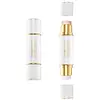What's inside
What's inside
 Key Ingredients
Key Ingredients

 Benefits
Benefits

 Concerns
Concerns

 Ingredients Side-by-side
Ingredients Side-by-side

Water
Skin ConditioningGlycerin
HumectantSorbitol
HumectantPropanediol
SolventButylene Glycol
HumectantAloe Barbadensis Leaf Juice
Skin ConditioningNiacinamide
SmoothingHibiscus Rosa-Sinensis Flower Extract
HumectantHylocereus Undatus Fruit Extract
Skin ConditioningKappaphycus Alvarezii Extract
Skin ConditioningTremella Fuciformis Polysaccharide
Emulsion StabilisingChlorella Ferment
Skin ConditioningTocopherol
AntioxidantMaris Aqua
HumectantAllantoin
Skin ConditioningAgarose
Skin ConditioningCarbomer
Emulsion StabilisingSodium Hydroxide
BufferingGlyceryl Acrylate/Acrylic Acid Copolymer
HumectantPvm/Ma Copolymer
Emulsion StabilisingPotassium Carbonate
BufferingCitric Acid
Buffering1,2-Hexanediol
Skin ConditioningCaprylyl Glycol
EmollientEthylhexylglycerin
Skin ConditioningBenzoic Acid
MaskingPotassium Sorbate
PreservativeSodium Benzoate
MaskingBenzyl Alcohol
PerfumingPhenoxyethanol
PreservativeParfum
MaskingLinalool
PerfumingCI 45380
Cosmetic ColorantCI 45410
Cosmetic ColorantCI 17200
Cosmetic ColorantWater, Glycerin, Sorbitol, Propanediol, Butylene Glycol, Aloe Barbadensis Leaf Juice, Niacinamide, Hibiscus Rosa-Sinensis Flower Extract, Hylocereus Undatus Fruit Extract, Kappaphycus Alvarezii Extract, Tremella Fuciformis Polysaccharide, Chlorella Ferment, Tocopherol, Maris Aqua, Allantoin, Agarose, Carbomer, Sodium Hydroxide, Glyceryl Acrylate/Acrylic Acid Copolymer, Pvm/Ma Copolymer, Potassium Carbonate, Citric Acid, 1,2-Hexanediol, Caprylyl Glycol, Ethylhexylglycerin, Benzoic Acid, Potassium Sorbate, Sodium Benzoate, Benzyl Alcohol, Phenoxyethanol, Parfum, Linalool, CI 45380, CI 45410, CI 17200
Hydrogenated Polyisobutene
EmollientDiethylhexyl Adipate
EmollientDimethicone
EmollientMica
Cosmetic ColorantPolyethylene
AbrasiveEuphorbia Cerifera Wax
Talc
AbrasiveSilica
AbrasivePolymethyl Methacrylate
Silica Dimethyl Silylate
EmollientPolyglyceryl-3 Diisostearate
EmulsifyingAscorbyl Palmitate
AntioxidantCetearyl Ethylhexanoate
EmollientCholesteryl Hydroxystearate
EmollientCitric Acid
BufferingGlyceryl Oleate
EmollientGlyceryl Stearate
EmollientHydrogenated Microcrystalline Wax
Emulsion StabilisingLecithin
EmollientNylon-12
Octyldodecanol
EmollientOctyldodecyl Stearoyl Stearate
EmollientOryza Sativa Bran Oil
EmollientSimmondsia Chinensis Seed Oil
EmollientSynthetic Wax
AbrasiveTocopherol
AntioxidantCI 77891
Cosmetic ColorantCI 77491
Cosmetic ColorantHydrogenated Polyisobutene, Diethylhexyl Adipate, Dimethicone, Mica, Polyethylene, Euphorbia Cerifera Wax, Talc, Silica, Polymethyl Methacrylate, Silica Dimethyl Silylate, Polyglyceryl-3 Diisostearate, Ascorbyl Palmitate, Cetearyl Ethylhexanoate, Cholesteryl Hydroxystearate, Citric Acid, Glyceryl Oleate, Glyceryl Stearate, Hydrogenated Microcrystalline Wax, Lecithin, Nylon-12, Octyldodecanol, Octyldodecyl Stearoyl Stearate, Oryza Sativa Bran Oil, Simmondsia Chinensis Seed Oil, Synthetic Wax, Tocopherol, CI 77891, CI 77491
 Reviews
Reviews

Ingredients Explained
These ingredients are found in both products.
Ingredients higher up in an ingredient list are typically present in a larger amount.
Citric Acid is an alpha hydroxy acid (AHA) naturally found in citrus fruits like oranges, lemons, and limes.
Like other AHAs, citric acid can exfoliate skin by breaking down the bonds that hold dead skin cells together. This helps reveal smoother and brighter skin underneath.
However, this exfoliating effect only happens at high concentrations (20%) which can be hard to find in cosmetic products.
Due to this, citric acid is usually included in small amounts as a pH adjuster. This helps keep products slightly more acidic and compatible with skin's natural pH.
In skincare formulas, citric acid can:
While it can provide some skin benefits, research shows lactic acid and glycolic acid are generally more effective and less irritating exfoliants.
Most citric acid used in skincare today is made by fermenting sugars (usually from molasses). This synthetic version is identical to the natural citrus form but easier to stabilize and use in formulations.
Read more about some other popular AHA's here:
Learn more about Citric AcidTocopherol (also known as Vitamin E) is a common antioxidant used to help protect the skin from free-radicals and strengthen the skin barrier. It's also fat soluble - this means our skin is great at absorbing it.
Vitamin E also helps keep your natural skin lipids healthy. Your lipid skin barrier naturally consists of lipids, ceramides, and fatty acids. Vitamin E offers extra protection for your skin’s lipid barrier, keeping your skin healthy and nourished.
Another benefit is a bit of UV protection. Vitamin E helps reduce the damage caused by UVB rays. (It should not replace your sunscreen). Combining it with Vitamin C can decrease sunburned cells and hyperpigmentation after UV exposure.
You might have noticed Vitamin E + C often paired together. This is because it is great at stabilizing Vitamin C. Using the two together helps increase the effectiveness of both ingredients.
There are often claims that Vitamin E can reduce/prevent scarring, but these claims haven't been confirmed by scientific research.
Learn more about Tocopherol